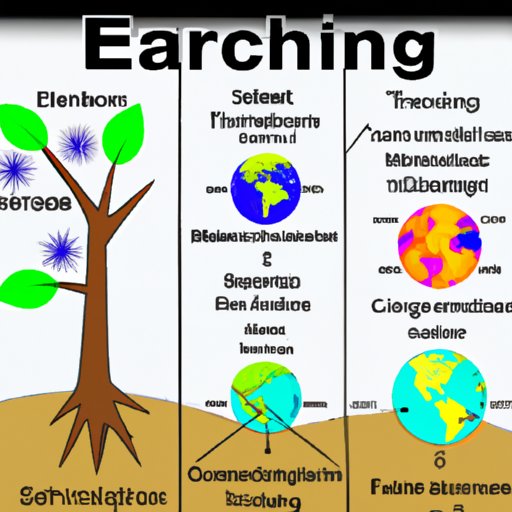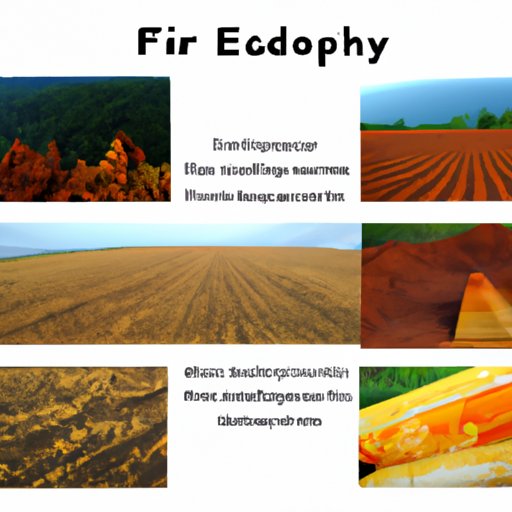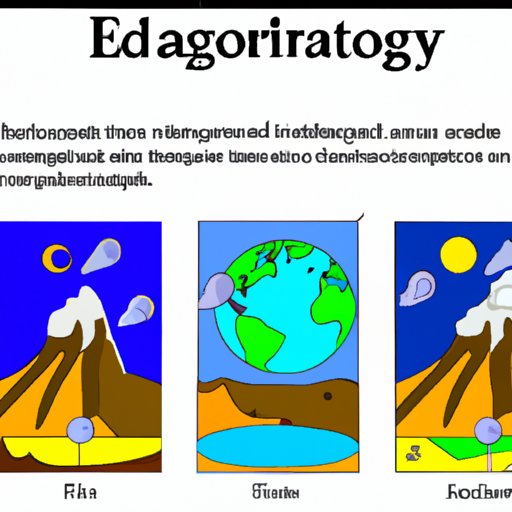Introduction
Earth science is the study of the physical characteristics and processes that make up our planet. It is an interdisciplinary field, combining the knowledge of multiple scientific disciplines such as physics, chemistry, biology, and mathematics to understand the world around us. Earth science encompasses a wide range of topics, from the inner workings of the Earth’s core to the outer reaches of space.
The purpose of this article is to explore the five main branches of Earth science: geology, hydrology, oceanography, meteorology, and astronomy. We will look at what each of these fields of study entails and how they are connected. We will also examine the different sub-disciplines within each branch and how they contribute to our overall understanding of Earth science.

Exploring the Five Branches of Earth Science
Geology is the study of the Earth’s structure, composition, and physical history. It examines the materials that make up our planet, as well as the processes that shape it. Geologists study plate tectonics, mineralogy, volcanology, and structural geology to understand the Earth’s evolution over time.
Hydrology is the study of water on Earth, including both surface water and groundwater. Hydrologists examine how water moves through the environment and the effects of human activities on water resources. They investigate topics such as surface water, groundwater, and environmental hydrology.
Oceanography is the study of the oceans and their interactions with other parts of the Earth system. It involves the study of the physical, chemical, and biological properties of the ocean. Oceanographers research topics such as physical oceanography, biological oceanography, and chemical oceanography.
Meteorology is the study of the atmosphere and how it affects the Earth’s climate and weather. Meteorologists investigate topics such as atmospheric dynamics, weather forecasting, and climate change.
Astronomy is the study of the universe beyond our own planet. Astronomers research topics such as the solar system, stars and galaxies, and cosmology.

A Look at the Different Fields of Earth Science
Let’s take a closer look at the different fields of study within each branch of Earth science.
Geology
Geology is the study of the Earth’s structure, composition, and physical history. It examines the materials that make up our planet, as well as the processes that shape it. Geologists study plate tectonics, which is the study of the large-scale motion of the Earth’s lithosphere (the outermost layer of the Earth). They also study mineralogy, which is the study of minerals and the processes by which they form. Volcanology is the study of volcanic activity and eruptions, while structural geology is the study of the deformation of rocks in the Earth’s crust.
Hydrology
Hydrology is the study of water on Earth, including both surface water and groundwater. Hydrologists examine how water moves through the environment and the effects of human activities on water resources. They investigate topics such as surface water, which is the portion of water found on the Earth’s surface, such as rivers and lakes; groundwater, which is the water found beneath the Earth’s surface; and environmental hydrology, which is the study of the interaction between water and the environment.
Oceanography
Oceanography is the study of the oceans and their interactions with other parts of the Earth system. It involves the study of the physical, chemical, and biological properties of the ocean. Oceanographers research topics such as physical oceanography, which is the study of the physical characteristics of the ocean, such as temperature and currents; biological oceanography, which is the study of marine life and ecosystems; and chemical oceanography, which is the study of the chemical composition of the ocean.
Meteorology
Meteorology is the study of the atmosphere and how it affects the Earth’s climate and weather. Meteorologists investigate topics such as atmospheric dynamics, which is the study of the motion of air in the atmosphere; weather forecasting, which is the prediction of future weather conditions; and climate change, which is the study of long-term changes in the Earth’s climate.
Astronomy
Astronomy is the study of the universe beyond our own planet. Astronomers research topics such as the solar system, which is the collection of planets, asteroids, comets, and other objects that orbit the Sun; stars and galaxies, which are collections of stars and other celestial bodies; and cosmology, which is the study of the origin, evolution, and eventual fate of the universe.
Examining the Five Disciplines of Earth Science
Now that we have looked at the different fields of study within each branch of Earth science, let’s examine how these disciplines work together to form a comprehensive understanding of our planet.
Geology
Geology is the study of the Earth’s structure, composition, and physical history. It examines the materials that make up our planet, as well as the processes that shape it. Geologists study plate tectonics, which is the study of the large-scale motion of the Earth’s lithosphere (the outermost layer of the Earth). They also study mineralogy, which is the study of minerals and the processes by which they form. Volcanology is the study of volcanic activity and eruptions, while structural geology is the study of the deformation of rocks in the Earth’s crust.
Hydrology
Hydrology is the study of water on Earth, including both surface water and groundwater. Hydrologists examine how water moves through the environment and the effects of human activities on water resources. They investigate topics such as surface water, which is the portion of water found on the Earth’s surface, such as rivers and lakes; groundwater, which is the water found beneath the Earth’s surface; and environmental hydrology, which is the study of the interaction between water and the environment.
Oceanography
Oceanography is the study of the oceans and their interactions with other parts of the Earth system. It involves the study of the physical, chemical, and biological properties of the ocean. Oceanographers research topics such as physical oceanography, which is the study of the physical characteristics of the ocean, such as temperature and currents; biological oceanography, which is the study of marine life and ecosystems; and chemical oceanography, which is the study of the chemical composition of the ocean.
Meteorology
Meteorology is the study of the atmosphere and how it affects the Earth’s climate and weather. Meteorologists investigate topics such as atmospheric dynamics, which is the study of the motion of air in the atmosphere; weather forecasting, which is the prediction of future weather conditions; and climate change, which is the study of long-term changes in the Earth’s climate.
Astronomy
Astronomy is the study of the universe beyond our own planet. Astronomers research topics such as the solar system, which is the collection of planets, asteroids, comets, and other objects that orbit the Sun; stars and galaxies, which are collections of stars and other celestial bodies; and cosmology, which is the study of the origin, evolution, and eventual fate of the universe.

How the Five Branches of Earth Science Work Together
Earth science is an interdisciplinary field, meaning that the various branches of Earth science are interconnected and work together to form a comprehensive understanding of our planet. Each branch of Earth science contributes to our overall knowledge of how the Earth works and how it has evolved over time.
The interconnected nature of Earth science means that collaboration between scientists is essential. For example, geologists and hydrologists may work together to study the impact of human activities on groundwater resources. Similarly, oceanographers and meteorologists may collaborate to study the effects of climate change on ocean temperatures. These types of cross-disciplinary studies are essential for gaining a comprehensive understanding of the Earth and its processes.
Conclusion
In conclusion, the five branches of Earth science – geology, hydrology, oceanography, meteorology, and astronomy – all contribute to our overall understanding of our planet. Each branch has its own unique set of fields of study, but they are all interconnected and work together to form a comprehensive understanding of the Earth. Collaboration between scientists from different disciplines is essential for gaining a complete picture of the Earth and its processes.
By understanding the five branches of Earth science, we can gain a better appreciation for our planet and the role we play in its health and sustainability. With this knowledge, we can make more informed decisions about how we use and protect the Earth’s resources.
(Note: Is this article not meeting your expectations? Do you have knowledge or insights to share? Unlock new opportunities and expand your reach by joining our authors team. Click Registration to join us and share your expertise with our readers.)
